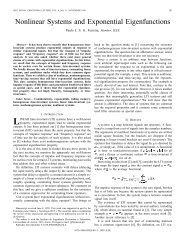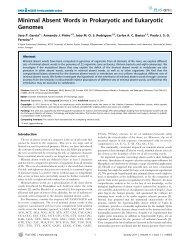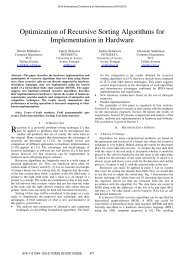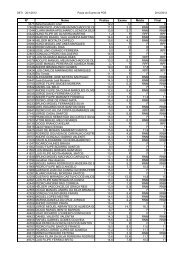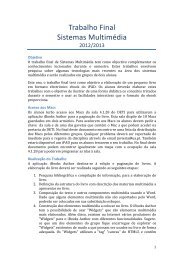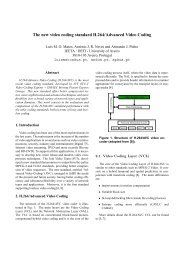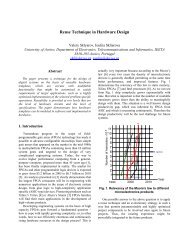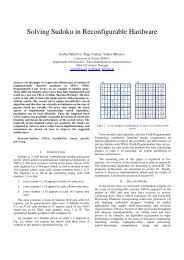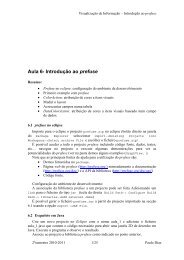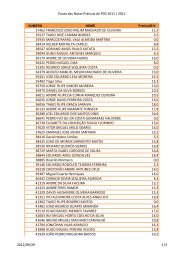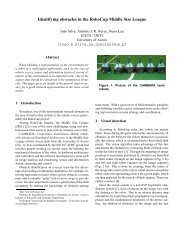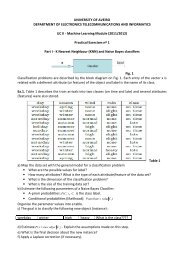DATA SHEET - IEETA
DATA SHEET - IEETA
DATA SHEET - IEETA
Create successful ePaper yourself
Turn your PDF publications into a flip-book with our unique Google optimized e-Paper software.
Philips Semiconductors Product specification<br />
8-bit microcontroller with on-chip CAN P8xC592<br />
13.5.19.3 Time Segment 2 (TSEG2)<br />
This time segment provides:<br />
• Additional time at the sample point for calculation of the<br />
subsequent bit levels (e.g. arbitration)<br />
• Synchronization buffer segment directly after the<br />
sample point.<br />
TSEG2 is programmable from 1 to 8 system clock cycles<br />
(see Section 13.5.10).<br />
13.5.19.4 Synchronisation Jump Width (SJW)<br />
SJW defines the maximum number of clock cycles (tSCL) a<br />
period may be reduced or increased by one<br />
resynchronization. SJW is programmable from 1 to 4<br />
system clock cycles, see Section 13.5.2.<br />
13.5.19.5 Propagation Delay Time (tprop)<br />
The Propagation Delay Time is:<br />
tprop = 2 × ( physical bus delay<br />
+ input comparator delay<br />
+ output driver delay)<br />
.<br />
tprop is rounded up to the nearest multiple of tSCL.<br />
13.5.19.6 Bit Timing Restrictions<br />
Restrictions on the configuration of the bit timing are based<br />
on internal processing. The restrictions are:<br />
• tTSEG2 ≥ 2tSCL<br />
• tTSEG2 ≥ tSJW<br />
• tTSEG1 ≥ tSEG2<br />
• tTSEG1 ≥ tSJW + tprop.<br />
The three sample mode (SAM = HIGH) has the effect of<br />
introducing a delay of one system clock cycle on the<br />
bus-line. This must be taken into account for the correct<br />
calculation of TSEG1 and TSEG2:<br />
• tTSEG1 ≥ tSJW + tprop + 2tSCL<br />
• tTSEG2 ≥ 3tSCL.<br />
13.5.20 SYNCHRONIZATION<br />
Synchronization is performed by a state machine which<br />
compares the incoming edge with its actual bit timing and<br />
adapts the bit timing by hard synchronization or<br />
resynchronization.<br />
1996 Jun 27 53<br />
This type of synchronization occurs only at the beginning<br />
of a message.<br />
The CAN-controller synchronizes on the first incoming<br />
recessive-to-dominant edge of a message (being the<br />
leading edge of a message's Start-Of-Frame bit;<br />
see Section 13.6.2.<br />
Resynchronization occurs during the transmission of a<br />
message's bit stream to compensate for:<br />
• Variations in individual CAN-controller oscillator<br />
frequencies<br />
• Changes introduced by switching from one transmitter<br />
to another (e.g. during arbitration).<br />
As a result of resynchronization either tTSEG1 may be<br />
increased by up to a maximum of tSJW or tTSEG2 may be<br />
decreased by up to a maximum of tSJW:<br />
• tTSEG1 ≤ tSCL [(TSEG1 + 1) + (SJW + 1)]<br />
• tTSEG2 ≥ tSCL [(TSEG2 + 1) − (SJW + 1)].<br />
TSEG1, TSEG2 and SJW are the programmed numerical<br />
values.<br />
The phase error (e) of an edge is given by the position of<br />
the edge relative to SYNCSEG, measured in system clock<br />
cycles (tSCL).<br />
The value of the phase error is defined as:<br />
• e = 0, if the edge occurs within SYNCSEG<br />
• e > 0, if the edge occurs within TSEG1<br />
• e < 0, if the edge occurs within TSEG2.<br />
The effect of resynchronization is:<br />
• The same as that of a hard synchronization, if the<br />
magnitude of the phase error (e) is less or equal to the<br />
programmed value of tSJW<br />
• To increase a bit period by the amount of tSJW, if the<br />
phase error is positive and the magnitude of the phase<br />
error is larger than tSJW<br />
• To decrease a bit period by the amount of tSJW, if the<br />
phase error is negative and the magnitude of the phase<br />
error is larger than tSJW.



